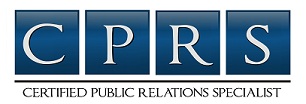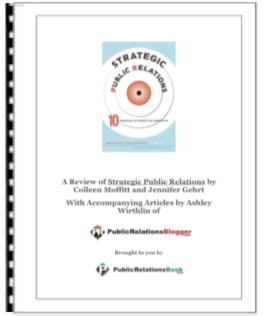________________________________________________________________________
 Although, as a business, non-profit or association manager, you may be glad this came your way.
Although, as a business, non-profit or association manager, you may be glad this came your way.
Especially if your current public relations effort is delivering more publicity plugs than real behavior change among your most important outside audiences. Change that could lead directly to achieving your managerial objectives.
I’m talking about persuading those key outside folks to your way of thinking, then moving them to take actions that help your department, division or subsidiary succeed.
There’s even a blueprint to help you do it. People act on their own perception of the facts before them, which leads to predictable behaviors about which something can be done. When we create, change or reinforce that opinion by reaching, persuading and moving-to-desired-action the very people whose behaviors affect the organization the most, the public relations mission is accomplished.
What kind of results can you expect? Consider these: membership applications on the rise; customers starting to make repeat purchases; fresh proposals for strategic alliances and joint ventures; community leaders beginning to seek you out; welcome bounces in show room visits; prospects starting to do business with you; higher employee retention rates, capital givers or specifying sources beginning to look your way, and even politicians and legislators starting to view you as a key member of the business, non-profit or association communities.
An obvious first step involves getting the public relations people assigned to your unit on board. Make certain the whole team buys into why it’s so important to know how your outside audiences perceive your operations, products or services. Be sure they accept the reality that perceptions almost always lead to behaviors that can hurt your unit.
Review how you plan to monitor and gather perceptions by questioning members of your most important outside audiences. Questions like these: how much do you know about our organization? Have you had prior contact with us and were you pleased with the interchange? How much do you know about our services or products and employees? Have you experienced problems with our people or procedures?
Since your PR people are in the perception and behavior business to begin with, they can be of real use for this opinion monitoring project. Professional survey firms are always available, but that can be a budget buster. Whether it’s your people or a survey firm who asks the questions, your objective is to identify untruths, false assumptions, unfounded rumors, inaccuracies, and misconceptions .
Then you must carefully select which of the above becomes your corrective public relations goal -- clarify the misconception, spike that rumor, correct the false assumption or fix certain other inaccuracies.
You can achieve your goal by picking the right strategy from the three choices available to you. Change existing perception, create perception where there may be none, or reinforce it. But be sure your new strategy fits comfortably with your new public relations goal.
But what will you say when you have the opportunity to address your key stakeholder audience to help persuade them to your way of thinking?
Select your best writer to prepare the message because s/he must put together some very special, corrective language. Words that are not only compelling, persuasive and believable, but clear and factual if they are to shift perception/opinion towards your point of view and lead to the behaviors you have in mind.
Happily, the next step is easy. You select communications tactics to carry your message to the attention of your target audience. Making certain that the tactics you select have a record of reaching folks like your audience members, you can pick from dozens that are available. From speeches, facility tours, emails and brochures to consumer briefings, media interviews, newsletters, personal meetings and many others.
Since how one communicates often affects the credibility of the message, you may wish to deliver it in small getogethers like meetings and presentations rather than through a higher- profile media announcement.
You’ll soon feel pressure for signs of progress. And that means a second perception monitoring session with members of your external audience. Employing many of the same questions used in the first benchmark session, you will now be watching carefully for signs that the offending perception is being altered in your direction.
Luckily, matters can be accelerated by adding more communications tactics as well as increasing their frequencies.
This workable public relations blueprint will help you persuade your most important outside stakeholders to your way of thinking, then move them to behave in a way that leads to the success of your department, division or subsidiary.
So, while you may not have asked for this public relations advice, I hope you will agree that the people you deal with behave like everyone else - they act upon their perceptions of the facts they hear about you and your operation. Leaving you little choice but to deal promptly and effectively with those perceptions by doing what is necessary to reach and move your key external audiences to action.
About The Author
Bob Kelly counsels, writes and speaks to business, non-profit and association managers about using the fundamental premise of public relations to achieve their operating objectives. He has been DPR, Pepsi-Cola Co.; AGM-PR, Texaco Inc.; VP-PR, Olin Corp.; VP-PR, Newport News Shipbuilding & Drydock Co.; director of communi- cations, U.S. Department of the Interior, and deputy assistant press secretary, The White House. He holds a bachelor of science degree from Columbia University, major in public relations. Visit his website.
Article Source.
Tags: public relations department, tips for public relations, public relations
|

Tips for the Public Relations Department
________________________________________
 Although, as a business, non-profit or association manager, you may be glad this came your way.
Although, as a business, non-profit or association manager, you may be glad this came your way.Especially if your current public relations effort is delivering more publicity plugs than real behavior change among your most important outside audiences. Change that could lead directly to achieving your managerial objectives.
I’m talking about persuading those key outside folks to your way of thinking, then moving them to take actions that help your department, division or subsidiary succeed.
There’s even a blueprint to help you do it. People act on their own perception of the facts before them, which leads to predictable behaviors about which something can be done. When we create, change or reinforce that opinion by reaching, persuading and moving-to-desired-action the very people whose behaviors affect the organization the most, the public relations mission is accomplished.
What kind of results can you expect? Consider these: membership applications on the rise; customers starting to make repeat purchases; fresh proposals for strategic alliances and joint ventures; community leaders beginning to seek you out; welcome bounces in show room visits; prospects starting to do business with you; higher employee retention rates, capital givers or specifying sources beginning to look your way, and even politicians and legislators starting to view you as a key member of the business, non-profit or association communities.
An obvious first step involves getting the public relations people assigned to your unit on board. Make certain the whole team buys into why it’s so important to know how your outside audiences perceive your operations, products or services. Be sure they accept the reality that perceptions almost always lead to behaviors that can hurt your unit.
Review how you plan to monitor and gather perceptions by questioning members of your most important outside audiences. Questions like these: how much do you know about our organization? Have you had prior contact with us and were you pleased with the interchange? How much do you know about our services or products and employees? Have you experienced problems with our people or procedures?
Since your PR people are in the perception and behavior business to begin with, they can be of real use for this opinion monitoring project. Professional survey firms are always available, but that can be a budget buster. Whether it’s your people or a survey firm who asks the questions, your objective is to identify untruths, false assumptions, unfounded rumors, inaccuracies, and misconceptions .
Then you must carefully select which of the above becomes your corrective public relations goal -- clarify the misconception, spike that rumor, correct the false assumption or fix certain other inaccuracies.
You can achieve your goal by picking the right strategy from the three choices available to you. Change existing perception, create perception where there may be none, or reinforce it. But be sure your new strategy fits comfortably with your new public relations goal.
But what will you say when you have the opportunity to address your key stakeholder audience to help persuade them to your way of thinking?
Select your best writer to prepare the message because s/he must put together some very special, corrective language. Words that are not only compelling, persuasive and believable, but clear and factual if they are to shift perception/opinion towards your point of view and lead to the behaviors you have in mind.
Happily, the next step is easy. You select communications tactics to carry your message to the attention of your target audience. Making certain that the tactics you select have a record of reaching folks like your audience members, you can pick from dozens that are available. From speeches, facility tours, emails and brochures to consumer briefings, media interviews, newsletters, personal meetings and many others.
Since how one communicates often affects the credibility of the message, you may wish to deliver it in small getogethers like meetings and presentations rather than through a higher- profile media announcement.
You’ll soon feel pressure for signs of progress. And that means a second perception monitoring session with members of your external audience. Employing many of the same questions used in the first benchmark session, you will now be watching carefully for signs that the offending perception is being altered in your direction.
Luckily, matters can be accelerated by adding more communications tactics as well as increasing their frequencies.
This workable public relations blueprint will help you persuade your most important outside stakeholders to your way of thinking, then move them to behave in a way that leads to the success of your department, division or subsidiary.
So, while you may not have asked for this public relations advice, I hope you will agree that the people you deal with behave like everyone else - they act upon their perceptions of the facts they hear about you and your operation. Leaving you little choice but to deal promptly and effectively with those perceptions by doing what is necessary to reach and move your key external audiences to action.
About The Author
Bob Kelly counsels, writes and speaks to business, non-profit and association managers about using the fundamental premise of public relations to achieve their operating objectives. He has been DPR, Pepsi-Cola Co.; AGM-PR, Texaco Inc.; VP-PR, Olin Corp.; VP-PR, Newport News Shipbuilding & Drydock Co.; director of communi- cations, U.S. Department of the Interior, and deputy assistant press secretary, The White House. He holds a bachelor of science degree from Columbia University, major in public relations. Visit his website.
Article Source.
Tags: public relations department, tips for public relations, public relations
|
| What did you think? |
Filed Under:
public relations,
Public Relations Department,
tips for public relations
Subscribe to:
Post Comments (Atom)






Comments (0)
Post a Comment